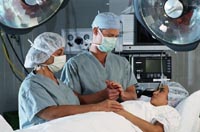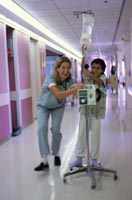About AHEC
| Partnerships |
The Area Health Education Center (AHEC) program at the University of Toledo College of Medicine and Life Sciences enhances access to quality health care, specifically primary and preventative care, by improving the supply and distribution of health care professionals through community and academic partnerships.
UToledo AHEC is part of the larger AHEC program that was designed by Congress in 1971 to recruit, train, and retain a health professions workforce committed to underserved populations. An AHEC is a network of regional centers that are coordinated through a central program office. There are approximately 55 AHEC programs with more than 300 centers, operating in almost every state. Nearly 85% of counties in the United States are services by an AHEC center.
Three regional centers are associated with UToledo's program office. They are:
- Bryan Area Health Education Center (BAHEC)
- Lima Area Health Education Center (LAHEC)
- Sandusky Area Health Education Center (SAHEC)
Approximately 250 regional physicians serve as preceptors for UToledo students and
hold volunteer faculty appointments at UToledo COMLS in their respective departments.
Several of the preceptors are UToledo College of Medicine graduates who completed
AHEC rotations as medical students.
Through these doctors, UToledo medical students gain ambulatory and inpatient hospital
clinical experience throughout northwest Ohio. Many hospitals provide free housing
and reduced cost meals for AHEC students. The regional AHEC centers work with health systems, hospitals, federally qualified
health centers, schools, health departments and other organizations to address specific
health care and workforce concerns of the communities.
The regional AHEC centers work with health systems, hospitals, federally qualified
health centers, schools, health departments and other organizations to address specific
health care and workforce concerns of the communities.
Each regional center is supported by an advisory board composed of community leaders
which addresses the health care needs of the local residents.
Back to Top
| Participants |
To graduate from The University of Toledo College of Medicine and Life Sciences, medical
students must complete eight weeks of an AHEC clinical clerkship. AHEC rotations are available in both the required third year clerkships, as well
as third and fourth year elective rotations.
Nursing and allied health students also receive clinical training through AHEC in
regional settings. AHEC training helps allied health students prepare for careers
as occupational and physical therapists, physician assistants and family nurse practitioners.
Back to Top
| Education Outreach |
 The centers develop health education programs for UToledo's medical students and local
health care professionals, school children, and citizens. Each center offers a variety
of programs in health care career education, community health education, continuing
medical education, clinical education and health workforce development.
The centers develop health education programs for UToledo's medical students and local
health care professionals, school children, and citizens. Each center offers a variety
of programs in health care career education, community health education, continuing
medical education, clinical education and health workforce development.
| Library Access and Resources |

Though the Internet, The University of Toledo Mulford Health Science Library connects rural health care providers from the three AHEC centers with the latest in medical information in online books, articles, and other resources, making it easier for our preceptors to stay up-to-date on the latest developments in health care without leaving their offices.
| Funding |
AHEC is funded by a line item appropriation in the state's budget. Additional support is provided by the Health Resources and Services Administration (HRSA) Bureau of Healthcare Workforce via the Point of Service Maintenance and Enhancement cooperative grant. The AHEC centers (BAHEC, LAHEC, and SAHEC) are supported by a variety of in-kind and fund raising contributions from the local communities.
| Impact |
 Impact for 2024-2025:
Impact for 2024-2025:
- 436 clinical rotations were provided for medical students in third-year required clerkships in primary care and a variety of third- and fourth-year electives.
- 213 volunteer physicians precepted students at 95 clinical training sites, including but not limited to federally qualified health centers, critical access and community hospitals, local health departments and community private practices.
- 26 ninth-grade students from rural and disadvantaged communities participated in the 25th annual CampMed program. CampMed is a two-day pathway program designed to inspire students to pursue careers in medicine and allied healthcare. Many alumni have gone on to work in healthcare careers in Northwest Ohio.



